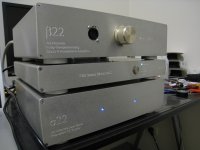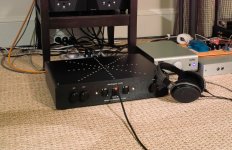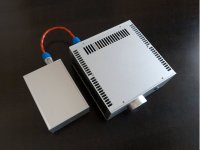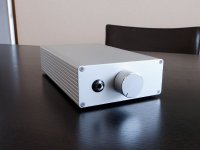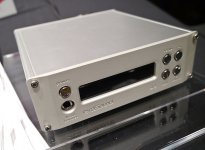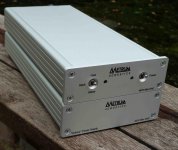Hi Neutrality,
How is the project going?
Have you been able to listen to it yet?
Also, I think you mentioned something about a sulzer regulator somewhere? I would be very interested in that too. I find there is a lack of good efficient low-noise regulators around here, and my projects need them.
How is the project going?
Have you been able to listen to it yet?
Also, I think you mentioned something about a sulzer regulator somewhere? I would be very interested in that too. I find there is a lack of good efficient low-noise regulators around here, and my projects need them.
Hi Neutrality,
How is the project going?
Have you been able to listen to it yet?
Also, I think you mentioned something about a sulzer regulator somewhere? I would be very interested in that too. I find there is a lack of good efficient low-noise regulators around here, and my projects need them.
I have had it up and running for a few weeks and have had some time to listen to it, so far I think it sounds great.
However, I am not done yet.
The Sulzer regulator, well, that is a no go.
I chose to stay with a good old fashioned LM317/LM337 regulated supply followed by a capacitance multiplier, it is what I have been used in other headphone amp projects, it just works and is low noise.
What is done :
Amplifier Boards
Cap Multiplier Board
What needs to be done :
Regulator Board(board is designed, just need to get it manufactured and assembled)
Volume Control Board(for a RK27 pot, board is designed, just need to get it manufactured and assembled )
Output Relay Board(For delayed ON/Fast OFF, output to a dual LED showing Standby/ON, board is designed, just need to get it manufactured and assembled)
Power Switch Driver Board(Enables the use of a Bulgin of similar momentary switch to turn the PSU ON/OFF, delivers the control signal and supply to the Ouput Relay Board, output to a dual LED showing Standby/ON, board design/layout in progress)
My plan is 2 x Amplifier board, 1 x Cap multiplier board, 1 x Output Relay board, 1 x Volume Control Board in one cabinet, 1 x Regulated supply, 1 x Power switch driver board and power transformer in another cabinet.
Cabinets conneced through a 6-pole XLR connecter, with +12V, GND, -12V for the amplifier as well as +12V, GND, CTRL signal for the Output Relay board.
Cabinets will be from Modushop, bottom and top covers for both amplifier and PSU will be in 3mm black anodized aluminium, designed in frontpanel express and manufactured by Schaeffer-ag. They will also handle the cutouts and drilling of the Modushop supplied 10mm black anodized front - 3mm black anodized back panels.
Cabinets are not going to be done anytime in the near future, I am counting on it being somewhere between 3-6 months from now before they are done. The cost is a little steep, but should be worth it.
The rest of the boards, as well as getting everything connected and tested should be done in 2 months or so.
Last edited:
Great! Allow for some suggestions that might be of some help?
Have you thought about combining regulator and cap multiplier on the same board, and put the transformer only in a separate box, bringing small AC to the amplifier enclosure? I think it would allow slightly easier case work (one less board to screw in). Also, wouldn't it lower a bit the supply rails impedance since the reg is closer to the amp board?
Regarding output relay and vandal-resistent switch controller, have you checked this? It is similar, and may save you some time, as pcbs are available:
The ε24 Power Switch Driver Circuit
The ε12 Muting / Protect Circuit
Regarding enclosure, I have tried Modushop, and find the finish sub-par (tolerances are rough, anodizing cheap, etc.) Prices are good for a big amplifier case, but for small enclosures, some research has led me to prefer the following:
Desktop Enclosures available from Context Engineering
Desk Top Enclosures (same products as above it seems)
ALMINIUM ENCLOSURE | TAKACHI ENCLOSURE
Hammond Mfg. - Small Enclosure Index
Lansing Instrument Enclosures E Style Overview
Box Enclosures - Product
Here are some examples of what is achievable with some of those cabinets:
Have you thought about combining regulator and cap multiplier on the same board, and put the transformer only in a separate box, bringing small AC to the amplifier enclosure? I think it would allow slightly easier case work (one less board to screw in). Also, wouldn't it lower a bit the supply rails impedance since the reg is closer to the amp board?
Regarding output relay and vandal-resistent switch controller, have you checked this? It is similar, and may save you some time, as pcbs are available:
The ε24 Power Switch Driver Circuit
The ε12 Muting / Protect Circuit
Regarding enclosure, I have tried Modushop, and find the finish sub-par (tolerances are rough, anodizing cheap, etc.) Prices are good for a big amplifier case, but for small enclosures, some research has led me to prefer the following:
Desktop Enclosures available from Context Engineering
Desk Top Enclosures (same products as above it seems)
ALMINIUM ENCLOSURE | TAKACHI ENCLOSURE
Hammond Mfg. - Small Enclosure Index
Lansing Instrument Enclosures E Style Overview
Box Enclosures - Product
Here are some examples of what is achievable with some of those cabinets:
Attachments
Great! Allow for some suggestions that might be of some help?
Have you thought about combining regulator and cap multiplier on the same board, and put the transformer only in a separate box, bringing small AC to the amplifier enclosure? I think it would allow slightly easier case work (one less board to screw in). Also, wouldn't it lower a bit the supply rails impedance since the reg is closer to the amp board?
Regarding output relay and vandal-resistent switch controller, have you checked this? It is similar, and may save you some time, as pcbs are available:
The ε24 Power Switch Driver Circuit
The ε12 Muting / Protect Circuit
Regarding enclosure, I have tried Modushop, and find the finish sub-par (tolerances are rough, anodizing cheap, etc.) Prices are good for a big amplifier case, but for small enclosures, some research has led me to prefer the following:
Desktop Enclosures available from Context Engineering
Desk Top Enclosures (same products as above it seems)
ALMINIUM ENCLOSURE | TAKACHI ENCLOSURE
Hammond Mfg. - Small Enclosure Index
Lansing Instrument Enclosures E Style Overview
Box Enclosures - Product
Here are some examples of what is achievable with some of those cabinets:
I am using a combined regulator and cap multiplier in one of my other amplifiers but I like to have it seperated in 2 different cabinets.
I am not too worried about supply output impedance since I am running the amps with enough class A bias to never leave class A for the loads that I need it to drive. As long you you stay within the class A capabilities of the amplifier it does not really matter. Besides, it is the cap multiplier that determines the final power supply output impedance.
I have seen those circuits from AMB.org but I prefer to make my own.
Modushop makes decent cabinets, I am using one right for my current head amp and I have had no issues, the qualtiy is satisfactory.
As you can see I have already planned everything. Iy might not be what everyone wants but it is how I would like to do it.
Last edited:
- Status
- This old topic is closed. If you want to reopen this topic, contact a moderator using the "Report Post" button.
